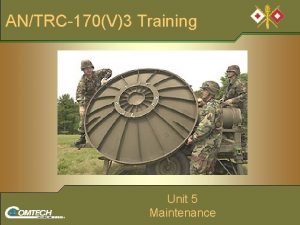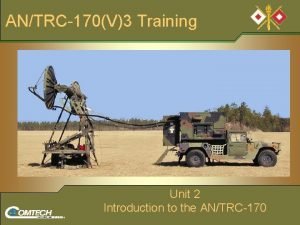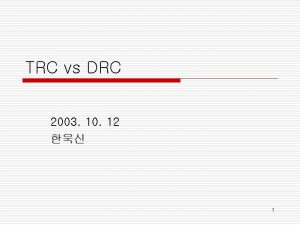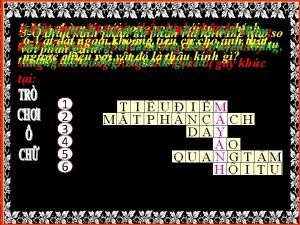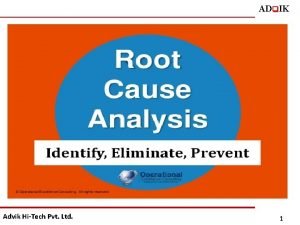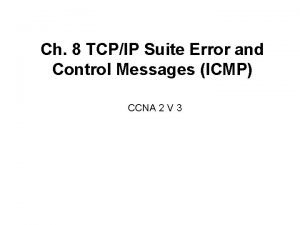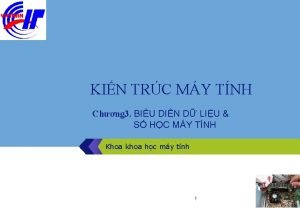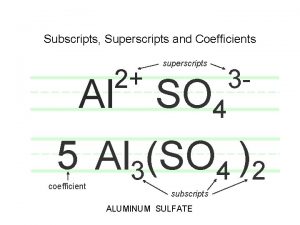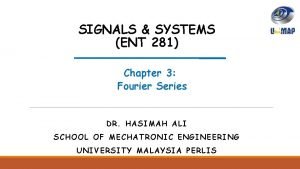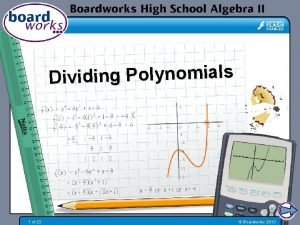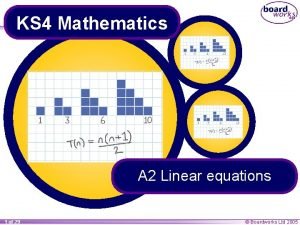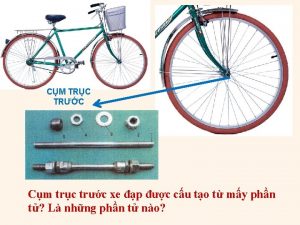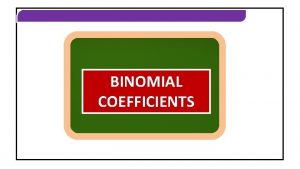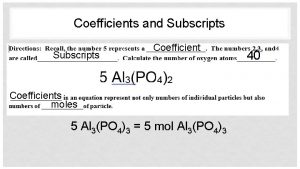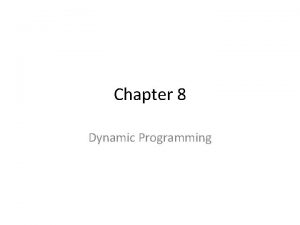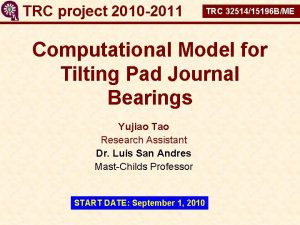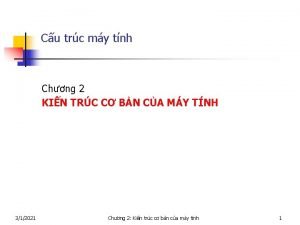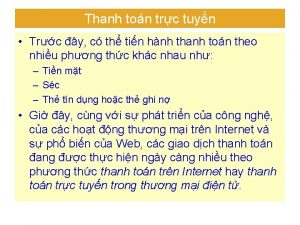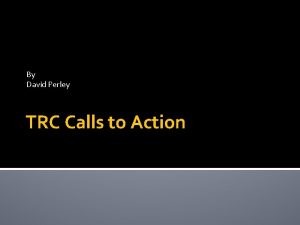TRC Project Predictions of Force Coefficients in OffCentered




















- Slides: 20

TRC Project: Predictions of Force Coefficients in Off-Centered Grooved Oil Seals A novel FE Bulk-Flow Model for Improved Predictions of Force Coefficients in Off. Centered Grooved Oil Seals Luis San Andrés Adolfo Delgado Mast-Childs Professor Research Assistant TRC-SEAL-1 -08 28 th TRC Annual Meeting 2008 TRC Project: 32513/1519 T 7

TRC Project: Predictions of Force Coefficients in Off-Centered Grooved Oil Seals Oil seals are commonly used to prevent leakage of process fluid in centrifugal compressors. - Locked oil seal rings can induce instability in compressors. - Seals are grooved to reduce cross-coupled stiffness and lower lock-up forces Oil seal in a compressors[1]

TRC Project: Predictions of Force Coefficients in Off-Centered Grooved Oil Seals Damping, Cross-coupled Stiffness & Inertia 2 L c Journal Constant pressure 2 -land seal: (deep groove divides lands) L 30 c 5 c c Short length seal Coeffs are ¼ of original seal

TRC Project: Predictions of Force Coefficients in Off-Centered Grooved Oil Seals Test Grooved Oil Seals Childs et al. , (2006) Single groove and multiple groove oil seal (single clearance) Childs et al. , (2007) One groove with groove depths (5 c, 10 c, 15 c) Results Added mass versus eccentricity ratios [Childs et. al] Force coefficients are underpredicted (grooved seal) Groove does not effectively separate seal lands Large added mass coefficients (~30 kg) Experimental Results

TRC Project: Predictions of Force Coefficients in Off-Centered Grooved Oil Seals Grooved Oil Seal: Predictions Groove should reduce crossedcoupled stiffness and damping coefficients by a factor of four Kxy (1 land)= 4 Kxy(2 lands) Cxx (1 land)= 4 Cxx(2 lands) Null (neglected) added mass coefficients ≠ Experiments Groove does not effectively separate seal lands ≠ At most Kxy (1 land) ~2 Kxy(2 lands) Cxx (1 land) ~2 Cxx(2 lands) ≠ Large added mass coefficients , increasing with increasing groove depth Need for better predictive models

TRC Project: Predictions of Force Coefficients in Off-Centered Grooved Oil Seals Improved predictive model TRC-SFD-2 -07 • Bulk flow, centered operation, incompressible fluid • Qualitative observations of laminar flow field • Boundary Conditions • Characteristic groove depth oil supply, Ps feed plenum groove mid-land groove Ps- Pd >0 Pd : discharge pressure Pd y z Streamlines in axially symmetric grooved annular cavity. Pd

TRC Project: Predictions of Force Coefficients in Off-Centered Grooved Oil Seals Bulk flow model Centered operation No fluid advection Separate flow regions Oil supply 1 z. I I 2 z. II II 3 III z. III 4 IV z. IV Reynolds eqn with temporal fluid inertia n z. N N n+1

TRC Project: Predictions of Force Coefficients in Off-Centered Grooved Oil Seals Finite Element Solution x= q. R Off-centered operation Film thickness Reynolds eqn. with temporal fluid inertia h R w e De X W Y

TRC Project: Predictions of Force Coefficients in Off-Centered Grooved Oil Seals FEM for solution of Pressure field Assemble system of equations, impose boundary conditions and solve

TRC Project: Predictions of Force Coefficients in Off-Centered Grooved Oil Seals Excel® GUI: XFEGLOSeal User inputs: -Fluid properties: Density and viscosity -Operating conditions: Inlet and outlet pressures, static journal eccentricity. (XFinite. Element. Grooved. Laminar. Oil. SEAL) -Geometry: Rotor diameter, clearance, groove depth, number of grooves, inlet and outlet land length, inter-groove length, groove length.

TRC Project: Predictions of Force Coefficients in Off-Centered Grooved Oil Seals Outlet plane Test Grooved Oil Seal & FE mesh Grooves z q 2 p 0 Inlet plane x=Rq Oil supply 17 mm 25 mm 2 mm Clearance= 86 mm 136 c 76 c Journal diameter: 117 mm Childs, D. W. , Graviss, M. , and Rodriguez, L. E. , 2007, “The Influence of Groove Size on the Static and Rotordynamic Characteristics of Short, Laminar-Flow Annular Seals, ” ASME J. Tribol, 129(2), 398 -406. Seal length Discharge plenum Journal c (0 -15) c Parallel oil seals Configuration [Childs et al] Buffer seal

TRC Project: Predictions of Force Coefficients in Off-Centered Grooved Oil Seals Effective groove depth Ps CFD simulations show: streamline separating flow regions IS a physical boundary delimiting the domain for squeeze film flow due to journal radial motions. Pa Test seal Laminar flow Ps= supply pressure Pa= ambient pressure 10 c 15 c Inner groove close up (CFD -Pressure driven flow)

TRC Project: Predictions of Force Coefficients in Off-Centered Grooved Oil Seals Shaft speed: 10, 000 rpm Test data Load Static eccentricity ratio: 0, 0. 3, 0. 5, 0. 7 Supply pressure: 70 bar Journal center locus indicates seal operates with oil cavitation at the largest test eccentricities Journal locus Seal operating conditions

TRC Project: Predictions of Force Coefficients in Off-Centered Grooved Oil Seals 10, 000 rpm, 70 bar Smooth Seal Grooved Seal Predicted leakage correlates well with experiments for both smooth land grooved seal (ch = 7 c) (cg= 15 c) Leakage

TRC Project: Predictions of Force Coefficients in Off-Centered Grooved Oil Seals Cxx 10, 000 rpm, 70 bar Smooth Seal Grooved Seal Model predicts accurately reduction in direct damping due to inner land groove. Cyy Smooth Seal (ch = 7 c) (cg= 15 c) Grooved Seal Direct Damping

TRC Project: Predictions of Force Coefficients in Off-Centered Grooved Oil Seals 70 bar Eccentricity ratio=0 Smooth Seal Grooved Seal Kxy Eccentricity ratio=0. 3 e = 0, 0. 3 Model effectively predicts reduction in cross-coupled stiffness due to mid-land groove. Smooth Seal Grooved Seal (ch = 7 c) (cg= 15 c) Kxy Cross-coupled Stiffness

TRC Project: Predictions of Force Coefficients in Off-Centered Grooved Oil Seals 10, 000 rpm, 70 bar Experimental data shows relatively large added mass coefficients. Predictions correlate well with experimental results. Mxx Grooved Seal Smooth Seal Added mass coefficients are larger for grooved seal Classical theory [1] predicts ~ 1/10 of test value (ch = 7 c) (cg= 15 c) [1] Reinhardt, F. , and Lund, J. W. , 1975, “The Influence of Fluid Inertia on the Dynamic Properties of Journal Bearings, ” ASME J. Lubr. Technol. , 97(1), pp. 154 -167. Added Mass

TRC Project: Predictions of Force Coefficients in Off-Centered Grooved Oil Seals Conclusions: • Predictions accurately capture the reduction of force coefficients on oil seals due to the addition of circumferential grooves. • Predicted force coefficients (K, C, M) correlate well with experimental data. • Boundary conditions reproduce well physical system. • A groove does not fully uncouple adjacent film lands!!

TRC Project: Predictions of Force Coefficients in Off-Centered Grooved Oil Seals Boundary Conditions Flow continuity is automatically satisfied at boundaries Outlet plane Constant static pressure at exit plane P=Pexit Null dynamic pressure at exit plane Zeroth Order Pressure Field Groove Laminar flow First Order Pressure Field Groove Constant static pressure at inlet plane z Null axial flow rate (geometrical symmetry) P=Psupply x Inlet plane P(q, z)=P(q+2 p, z) For both the zeroth and first order fields the pressure field be periodic in the circumferential direction In the occurrence of oil cavitation (Pcav=0), the first order dynamic pressure field vanishes

TRC Project: Predictions of Force Coefficients in Off-Centered Grooved Oil Seals Semanate and San Andrés, (1993) Predictive Models - Bulk flow equation model - Grooves should reduce force coefficients by a factor of four, i. e. Kxy (1 land)= 4 Kxy(2 lands) Cxx (1 land)= 4 Cxx(2 lands) -Fluid inertia effects not predicted (considered negligible) Baheti and Kirk, (1995) - Reynolds and energy equation (Finite element solution) - Grooves should effectively isolate seal lands - Cross-coupled stiffness and damping coefficients are reduced by ~60 % for grooved configurations
 Trc force
Trc force Trc force
Trc force An/trc-170
An/trc-170 An/trc-170 troposcatter system
An/trc-170 troposcatter system Trc vs drc
Trc vs drc Trc reading levels chart
Trc reading levels chart T trc
T trc Centurylink penrose co
Centurylink penrose co Trc mrc root cause
Trc mrc root cause Dibels trc
Dibels trc 1 trc
1 trc Trc marc
Trc marc Trng
Trng Biểu diễn số thực 32 bit
Biểu diễn số thực 32 bit Trc t
Trc t Formula in chemistry
Formula in chemistry Superscript in chemical formula
Superscript in chemical formula Solve equations with rational coefficients
Solve equations with rational coefficients Trigonometric fourier series in signals and systems
Trigonometric fourier series in signals and systems Equating coefficients
Equating coefficients Solving equations with fractional coefficients
Solving equations with fractional coefficients


